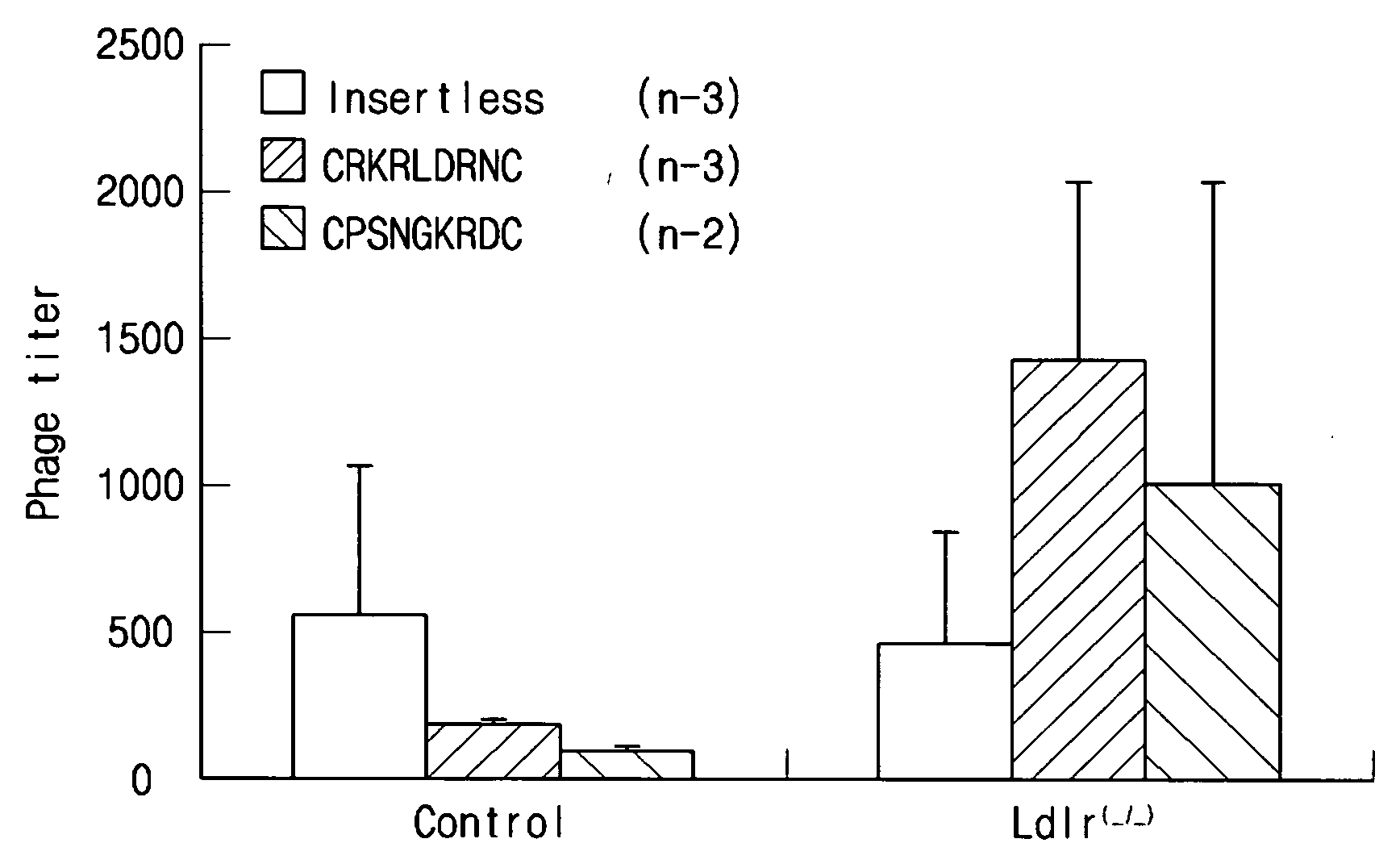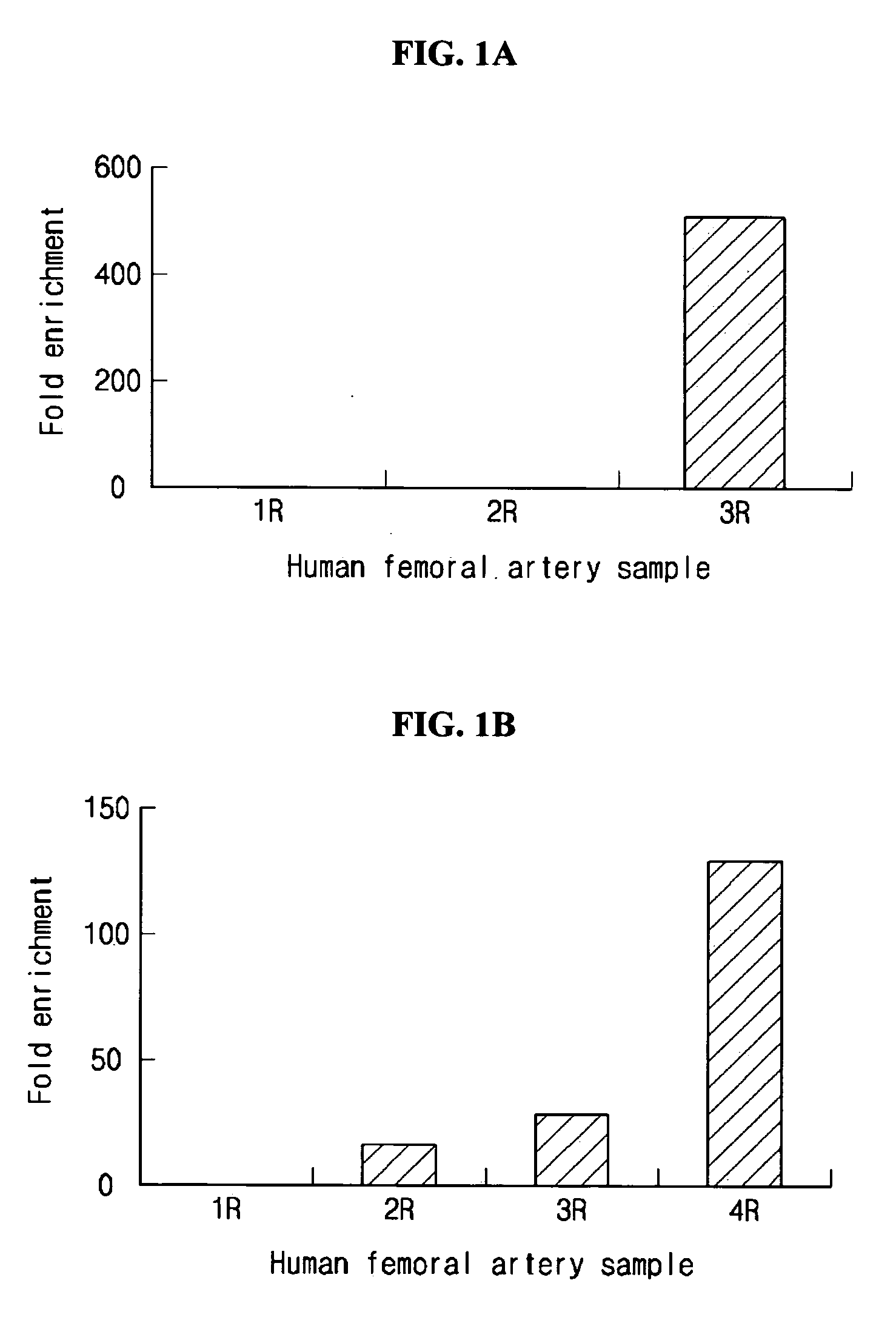Peptide for diagnosing, preventing and treating atherosclerosis and uses thereof
a technology of peptides and atherosclerosis, applied in the direction of peptide/protein ingredients, depsipeptides, dna/rna fragmentation, etc., can solve the problems of frequent occlusion, poor blood flow, and insufficient supply of blood to the hear
- Summary
- Abstract
- Description
- Claims
- Application Information
AI Technical Summary
Benefits of technology
Problems solved by technology
Method used
Image
Examples
example 1
Screening of Peptides Having Binding Specificity to Atherosclerotic Plaques
[0095]1-1. Construction of Phage Peptide Library
[0096]In order to find and screen peptides having specificity to atherosclerotic plaques, the present inventors adopted a phage peptide display technique (Smith, Science, 228:1315-1317, 1985). The phage peptide display is a technique to display a peptide consisting of several to several tens of amino acid residues on a surface of bacteriophage. Due to a capability to prepare a phage library having various peptides up to 109, the phage peptide display is a useful technique to find and screen a certain peptide which is capable of targeting a desired tissue or tumor, via simultaneous screening of various kinds of peptides.
[0097]In order to screen an atherosclerotic plaque tissue-specific peptide, a phage peptide library was constructed according to the following procedure: First, an oligonucleotide coding for a CX7C peptide having cysteine residues at both termini ...
example 2
In Vivo Targeting of Peptide to Atherosclerotic Plaques
[0103]2-1. Construction of Atherosclerosis Mouse Model
[0104]C57BL / 6 mice (Ldlr− / −) into which deficiency of a low-density lipoprotein (LDL) receptor was introduced by a genetic engineering technique were fed daily for 10 weeks with 3 g of high-cholesterol diet, thereby inducing atherosclerosis in animals. The high-cholesterol diet was a special animal feed containing 1.25% cholesterol, 15% fat and 0.5% cholate (Oriental Yeast Co., Japan).
[0105]2-2. In Vivo Atherosclerotic Targeting of Selected Phage Clones
[0106]Phages (1011 pfu) with insertion of the peptide (SEQ ID NO: 1 or SEQ ID NO: 2) selected in Section 1-2 of Example 1 were injected via caudal veins into the blood of atherosclerosis-induced mice and normal mice (wild-type) under anesthesia, followed by circulation for 15 min. Thereafter, aorta were removed from each mouse and aortic tissues were ground to collect cells. The cells were treated with 100 μl of DMEM containing...
example 3
Evaluation of IL-4R as Peptide Receptor
[0124]3-1. Histological Distribution of Peptide and IL-4R
[0125]In order to ascertain a receptor that binds to the peptide of the present invention, binding of the peptide was examined for various receptors. Out of those receptors, the results for IL-4R are as follows. First, fluorescein (FITC)-conjugated peptide of the present invention at a final concentration of 50 μM was injected into the blood of experimental animals, followed by circulation for 15 min. Thereafter, the aortae were removed from animals, and a frozen section slide was prepared. Then, the tissue section was stained by reaction of the section with antibodies (1:200 dilution, BD, USA) directed against IL-4R, at room temperature for 1 hour. In order to stain the tissue nuclei, DAPI was treated on the slide which was then examined under a fluorescence microscope (Joshi et al., Cancer Research, 61:8058-8061, 2001).
[0126]As shown in FIG. 5, the FITC-CRKRLDRNC peptide (green fluoresc...
PUM
| Property | Measurement | Unit |
|---|---|---|
| temperature | aaaaa | aaaaa |
| MW | aaaaa | aaaaa |
| superparamagnetic | aaaaa | aaaaa |
Abstract
Description
Claims
Application Information
 Login to View More
Login to View More - R&D
- Intellectual Property
- Life Sciences
- Materials
- Tech Scout
- Unparalleled Data Quality
- Higher Quality Content
- 60% Fewer Hallucinations
Browse by: Latest US Patents, China's latest patents, Technical Efficacy Thesaurus, Application Domain, Technology Topic, Popular Technical Reports.
© 2025 PatSnap. All rights reserved.Legal|Privacy policy|Modern Slavery Act Transparency Statement|Sitemap|About US| Contact US: help@patsnap.com



